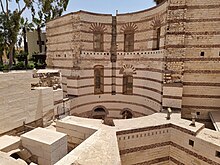Canal of the Pharaohs

The Canal of the Pharaohs, also called the Ancient Suez Canal or Necho's Canal, is the forerunner of the
Egyptian and Persian works
At least as far back as Aristotle there have been suggestions that perhaps as early as the
One of their kings tried to make a canal to it (for it would have been of no little advantage to them for the whole region to have become navigable; Sesostris is said to have been the first of the ancient kings to try), but he found that the sea was higher than the land. So he first, and Darius afterwards, stopped making the canal, lest the sea should mix with the river water and spoil it.[10]
Strabo also wrote that Sesostris started to build a canal, as did Pliny the Elder (see quote further down).[11]
However, the canal was probably first cut or at least begun by Necho II (r. 610–595 BC), in the late 7th century BC, and it was either re-dug or possibly completed by Darius the Great (r. 550–486 BC). Classical sources disagree as to when it was finally completed.[citation needed]
Pliny the Elder wrote:
165. Next comes the Tyro tribe and, on the Red Sea, the harbour of the Daneoi, from which Sesostris, king of Egypt, intended to carry a ship-canal to where the Nile flows into what is known as the Delta; this is a distance of over 60 miles. Later the Persian king Darius had the same idea, and yet again Ptolemy II, who made a trench 100 feet wide, 30 feet deep and about 35 miles long, as far as the Bitter Lakes.[11]
Although Herodotus (2.158) tells us Darius I continued work on the canal, Aristotle (Aristot. met. I 14 P 352b.), Strabo (Strab. XVII 1, 25 C 804. 805.), and Pliny the Elder (Plin. n. h. VI 165f.) all say that he failed to complete it,[16] while Diodorus Siculus does not mention a completion of the canal by Necho II.[17]
Greek, Roman and Islamic works
After the death of
Ptolemy II is credited by some for being the first to solve the problem of keeping the Nile free of salt water when his engineers invented the lock around 274/273 BC.[19]

The canal was reconstructed by
The canal was difficult to maintain and by the time of the
Aftermath
Thereafter, the land routes to
Following the discovery of a direct sea route to India through the Cape of Good Hope by Portugal, the Venetians and Mamluks negotiated with each other to fund the construction of a new canal in order to weaken Portuguese trade. However, the
Sokollu Mehmed Pasha, the Grand Vizier of the Ottoman Empire from 1565 to 1579, also considered constructing a new canal to reduce Portuguese dominance in the Indian Ocean and connect the divided Ottoman navy in the Mediterranean Sea and the Indian Ocean, but it was deemed too expensive to construct and was cancelled.[31]
During the
After over a millennium since its closure in 767, the Suez Canal re-established a direct sea route between the Mediterranean Sea and the Red Sea in 1869.
See also
Notes
- ^ Shahbazi, A. Shapur (15 December 1994). "DARIUS iii. Darius I the Great". Encyclopedia Iranica. New York. Retrieved 18 May 2011.
{{cite encyclopedia}}: CS1 maint: location missing publisher (link) - ISBN 978-1-57506-120-7.
- ^ Lendering, Jona. "Darius' Suez Inscriptions". Livius.org. Archived from the original on 26 December 2016. Retrieved 18 May 2011.
- ^ Munn-Rankin, J.M. (2011). "Darius I". London: Encyclopædia Britannica. Retrieved 18 May 2011.
- ^ Schörner 2000, p. 31, 40, fn. 33
- ^ Rappoport 1904, pp. 250-253
- ^ Moore 1950, pp. 99–101
- ^ Froriep 1986, p. 46
- ^ Schörner 2000, pp. 33–35
- ^ "Meteorology (1.15)". Archived from the original on 11 October 2018. Retrieved 26 August 2009.
- ^ ISBN 978-0-14-044413-1 p.70 [1]
- ISBN 0-543-99326-4, p. 366
- ISBN 0-631-21195-0, p.186
- ^ a b c d Redmount, Carol A. "The Wadi Tumilat and the «Canal of the Pharaohs»"Journal of Near Eastern Studies, Vol. 54, No. 2 (Apr. 1995), pp. 127–135
- ^ Carte hydrographique de l'Basse Egypte et d'une partie de l'Isthme de Suez (1855, 1882). Volume 87, page 803. Paris. See [2].
- ^ Schörner 2000, p. 40, fn. 33
- ^ Schörner 2000, p. 31
- ^ Schörner 2000, p. 34
- ISBN 978-0-567-02592-0p.236
- ^ a b Raymond 2000, pp. 2, 15–16.
- ^ a b Sheehan 2010, pp. 35–38.
- ^ Gabra et al. 2013, p. 21.
- ^ Sheehan 2010, pp. 38–39.
- ^ Sheehan 2010, p. 39.
- ^ Sheehan 2010, p. 38.
- ^ Sheehan 2010, pp. 58–59.
- ^ Sheehan 2010, pp. 52, 63–64.
- ^ Raymond 2000, p. 16.
- ISBN 978-0-691-65660-1.
- ^ Starthern, P. (2013) "The Venetians" p. 175
- ^ Rossi, N.; Rosand, David (2013). "Italian Renaissance Depictions of the Ottoman Sultan: Nuances in the Function of Early Modern Italian Portraiture". ProQuest.
References
- Froriep, Siegfried (1986): "Ein Wasserweg in Bithynien. Bemühungen der Römer, Byzantiner und Osmanen", Antike Welt, 2nd Special Edition, pp. 39–50
- Gabra, Gawdat; van Loon, Gertrud J.M.; Reif, Stefan; Swelim, Tarek (2013). Ludwig, Carolyn; Jackson, Morris (eds.). The History and Religious Heritage of Old Cairo: Its Fortress, Churches, Synagogue, and Mosque. American University in Cairo Press. ISBN 9789774167690.
- Moore, Frank Gardner (1950): "Three Canal Projects, Roman and Byzantine", American Journal of Archaeology, Vol. 54, No. 2, pp. 97–111
- Rappoport, S. (1904): "History of Egypt", Volume 3, Chapter V: "The Waterways of Egypt" pages 250–253. London: The Grolier Society.[3].
- Raymond, André (2000) [1993]. Cairo. Translated by Wood, Willard. Harvard University Press. ISBN 978-0-674-00316-3.
- Schörner, Hadwiga (2000): "Künstliche Schiffahrtskanäle in der Antike. Der sogenannte antike Suez-Kanal", Skyllis, Vol. 3, No. 1, pp. 28–43
- Sheehan, Peter (2010). Babylon of Egypt: The Archaeology of Old Cairo and the Origins of the City. Oxford University Press. ISBN 978-977-416-731-7.

